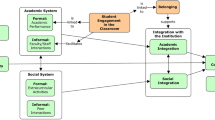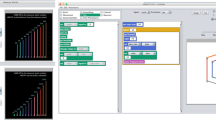Abstract
We investigate the dynamics of student engagement as it is manifest in self-directed, self-motivated, relatively long-term, computer-based scientific image processing activities. The raw data for the study are video records of 19 students, grades 7 to 11, who participated in intensive 6-week, extension summer courses. From this raw data we select episodes in which students appear to be highly engaged with the subject matter. We then attend to the fine-grained texture of students’ actions, identifying a core set of phenomena that cut across engagement episodes. Analyzed as a whole, these phenomena suggest that when working in self-directed, self-motivated mode, students pursue proposed activities but sporadically and spontaneously venture into self-initiated activities. Students’ recurring self-initiated activities – which we call personal excursions – are detours from proposed activities, but which align to a greater or lesser extent with the goals of such activities. Because of the deeply personal nature of excursions, they often result in students collecting resources that feed back into both subsequent excursions and framed activities. Having developed an understanding of students’ patterns of self-directed, self-motivated engagement, we then identify four factors that seem to bear most strongly on such patterns: (1) students’ competence (broadly construed); (2) features of the software-based activities, and how such features allowed students to express their competence; (3) the time allotted for students to pursue proposed activities, as well as self-initiated ones; and (4) the flexibility of the computational environment within which the activities were implemented.
Similar content being viewed by others
References
Ames C. (1992). Classrooms: Goals, structures and student motivation. Journal of Educational Psychology 84: 261–271
Azevedo, F. S. (1998). Inventing mapping: Meta-representational competence for spatially distributed data. Paper presented at the annual meeting of the American Educational Research Association, San Diego, CA
Azevedo F. S. (2000). Designing representations of terrain: A study in meta-representational competence. Journal of Mathematical Behavior 19(4): 443–480
Blumenfeld P. C., Soloway E., Marx R. W., Krajcik J. S., Guzdial M. and Palincsar A. (1991). Motivating project-based learning: Sustaining the doing, supporting the learning. Educational Psychologist 26(3 & 4): 369–398
Brown J. S., Collins A. and Duguid P. (1989). Situated cognition and the culture of learning. Educational researcher 18: 32–42
Cobb, P. and Hodge, L. L. (submitted for publication). An initial contribution to the development of a design theory of mathematical interests: The case of statistical data analysis
Cole, K. A. (1995). Structuring academic engagement in classrooms. Unpublished doctoral dissertation. Stanford University
Csikzentmihalyi M. (1988). The flow experience and its significance for human psychology. In: Csikzentmihalyi, M. and Csikzentmihalyi, I. S. (eds) Optimal Experience: Psychological Studies of Flow in Consciousness, pp 15–35. Cambridge University Press, New York, NY
Deci E. L. (1992). The relation of interest to motivation and human behavior: A self-determination of theory perspective. In: Renninger, K. A. and Hidi, S. (eds) The Role of Interest in Learning and Development, pp 43–70. Lawrence Erlbaum Associates, Hillsdale, NJ
Dewey J. (1913). Interest and Effort in Education. Riverside Press, Boston, MA
diSessa A. A. (1992). Images of learning. In: Linn, M. C., Mandl, H. and Verschaffel, L. (eds) Computer-based Learning Environments and Problem Solving, pp 19–40. Springer, Berlin
diSessa A. A. (2000.). Changing Minds: Computers, Learning and Literacy. MIT Press, Cambridge, MA
diSessa A. A. (2002). Students’ Criteria for Representational Adequacy. In: Lehrer, R. and Verschaffel, L. (eds) Symbolizing, Modeling and Tool Use in Mathematics Education, pp 105–129. Kluwer, Dordrecht
diSessa A. A., Hammer D., Sherin B. L. and Kolpakowsky T. (1991). Inventing graphing: Meta-representational expertise in children. Journal of Mathematical Behavior 10(2): 117–160
diSessa A. A. and Sherin B. L. (2000). Meta-representation: An introduction. Journal of Mathematical Behavior 19(4): 385–398
Dweck C. S. (1999). Self-theories: their Role in Motivation, Personality and Development. Psychology Press, Philadelphia, PA
Engeström Y. (1999). Activity theory and individual and social transformation. In: Engeström, Y., Miettinen, R. and Punamaki, R. (eds) Perspectives on Activity Theory, pp 19–38. Cambridge University Press, New York, NY
Engle R. A. and Conant F. R. (2002). Guiding principles for fostering productive disciplinary engagement: Explaining an emergent argument in a community of learners classroom. Cognition and Instruction 20: 399–483
Friedman, J. S. (1996). Image processing in a science classroom: A constructivist perspective on the role of prior knowledge. Paper presented at the annual meeting of the American Educational Research Association
Friedman J. S. and diSessa A. A. (1999). What students should know about technology: The case of scientific visualization. Journal of Science Education and Technology 8(3): 175–195
Gee J. P. (1999). An Introduction to Discourse Analysis: Theory and Method. Routledge, London
Granados R. (2000). Constructing intersubjectivity in representational design activities. Journal of Mathematical Behavior 19(4): 503–530
Greeno J. G. and Hall R. P. (1997). Practicing representation: Learning with and about representational forms. Phi Delta Kappan 78(5): 361–368
Herrenkohl L. R. and Guerra M. R. (1998). Participant structures, scientific discourse and student engagement in fourth grade. Cognition and Instruction 16(4): 431–473
Hickey D. T. (1997). Motivation and contemporary socio-constructivist instructional perspectives. Educational Psychologist 32: 175–193
Hickey D. T. and McCaslin M. (2001). A comparative, sociocultural analysis of context and motivation. In: Volet, S. and Jarvela, S. (eds) Motivation in Learning Contexts: Theoretical Advances and Methodological Implications, pp 33–55. Elsevier Science Ltd, Oxford, UK
Hidi S. and Harackiewicz J. M. (2000). Motivating the academically unmotivated: A critical issue for the 21st century. Review of Educational Research 70(2): 151–179
Janvier C. (1987). Problems of Representation in the Teaching and Learning of Mathematics. Lawrence Erlbaum Associates, Hillsdale, NJ
Krapp A., Hidi S. and Renninger K. A. (1992). Interest, learning, and development. In: Renninger, K. A., Hidi, S., and Krapp, A. (eds) The Role of Interest in Learning and Development, pp 3–25. Lawrence Erlbaum Associates, Hillsdale, NJ
Lepper M. R. and Cordova D. I. (1992). A desire to be taught: Instructional consequences of intrinsic motivation. Motivation and Emotion 16: 187–208
Linn, M. C. and Hsi, S. (2000). Computers, teachers, peers: Science learning partners. Hillsdale, NJ: Lawrence Erlbaum Associates, Inc
Lynch M. and Woolgar S. (1990). Representation in scientific practice. MIT press, Cambridge, MA
Madanes, R. (1997). Teaching through discussion: Using critical moves and support moves. Paper presented at the annual meeting of the American Education Research Association, Chicago, IL
Newman F. M., Wehlage G. G. and Lamborn S. (1992). The significance and sources of student engagement. In: Newman, F. (eds) Student Engagement and Achievement in American Secondary Schools, pp 11–39. Teachers College Press, New York, NY
Newman F. M. (1992). Student Engagement and Achievement in American Secondary Schools. Teachers College Press, New York, NY
Paris, S. G. and Turner, J. C. (1994). Situated motivation in P. Pintrich, D. Brown and C. Wenstein (Eds.), Student motivation, cognition, and learning: Essays in honor of Wilbert J. McKeachie. (pp. 213--237). Hillsdale, NJ: Lawrence Erlbaum Associates, Inc
Pintrich P. R. and Garcia T. (1991). Student Goal Orientation and Self-regulation in the College Classroom. In: Maehr, M. L. and Pintrich, P. R. (eds) Advances in Motivation and Achievement, pp 371–402. JAI Press, Greenwich, CT
Renninger K. A. (1992). Individual interest and development: Implications for theory and practice. In: Renninger, K. A., Hidi, S. and Krapp, A. (eds) The Role of Interest in Learning and Development, pp 361–376. Lawrence Erlbaum Associates, Hillsdale, NJ
Resnick M. (1996). Toward a practice of “constructional design”. In: Schauble, L. and Glaser, R. (eds) Innovations in Learning: New Environments for Education, pp 161–174. Lawrence Erlbaum Associates, Mahwah, NJ
Roschelle J. (1996). Designing for cognitive communication: Epistemic fidelity or mediating collaborative inquiry?. In: Day, D. L. and Kovacks, D. K. (eds) Computers, Communication and Mental Models, pp 15–27. Taylor & Francis, Philadelphia, PA
Sherin, B. L. (1997). The elements of representational design. Paper presented at the annual meeting of the American Education Research Association, Chicago, IL
Sherin B. (2000). How students invent representations of motion: A genetic account. Journal of Mathematical Behavior 19(4): 399–441
Thimbleby H. (1990). User Interface Design. Addison Wesley, Reading, MA
Volet S. and Järvelä S. (2001). Motivation in Learning Contexts: Theoretical Advances and Methodological Implications. Elsevier Science Ltd, Oxford, UK
Wilensky U. and Stroup W. M. (2000). Networked gridlock: Students enacting complex dynamic phenomena with the HubNet Architecture. In: Fishman, B. J. and O’Connor-Divelbiss, S. F. (eds) Proceedings of the International Conference of the Learning Sciences, pp 282–289. Lawrence Erlbaum Associates, Mahwah, NJ
Author information
Authors and Affiliations
Corresponding author
Rights and permissions
About this article
Cite this article
Azevedo, F.S. Personal Excursions: Investigating the Dynamics of Student Engagement. Int J Comput Math Learning 11, 57–98 (2006). https://doi.org/10.1007/s10758-006-0007-6
Published:
Issue Date:
DOI: https://doi.org/10.1007/s10758-006-0007-6




